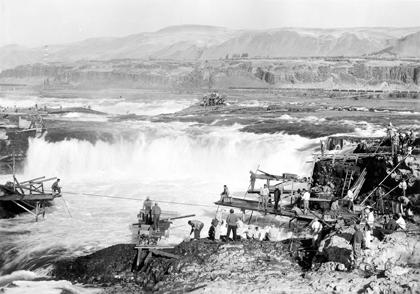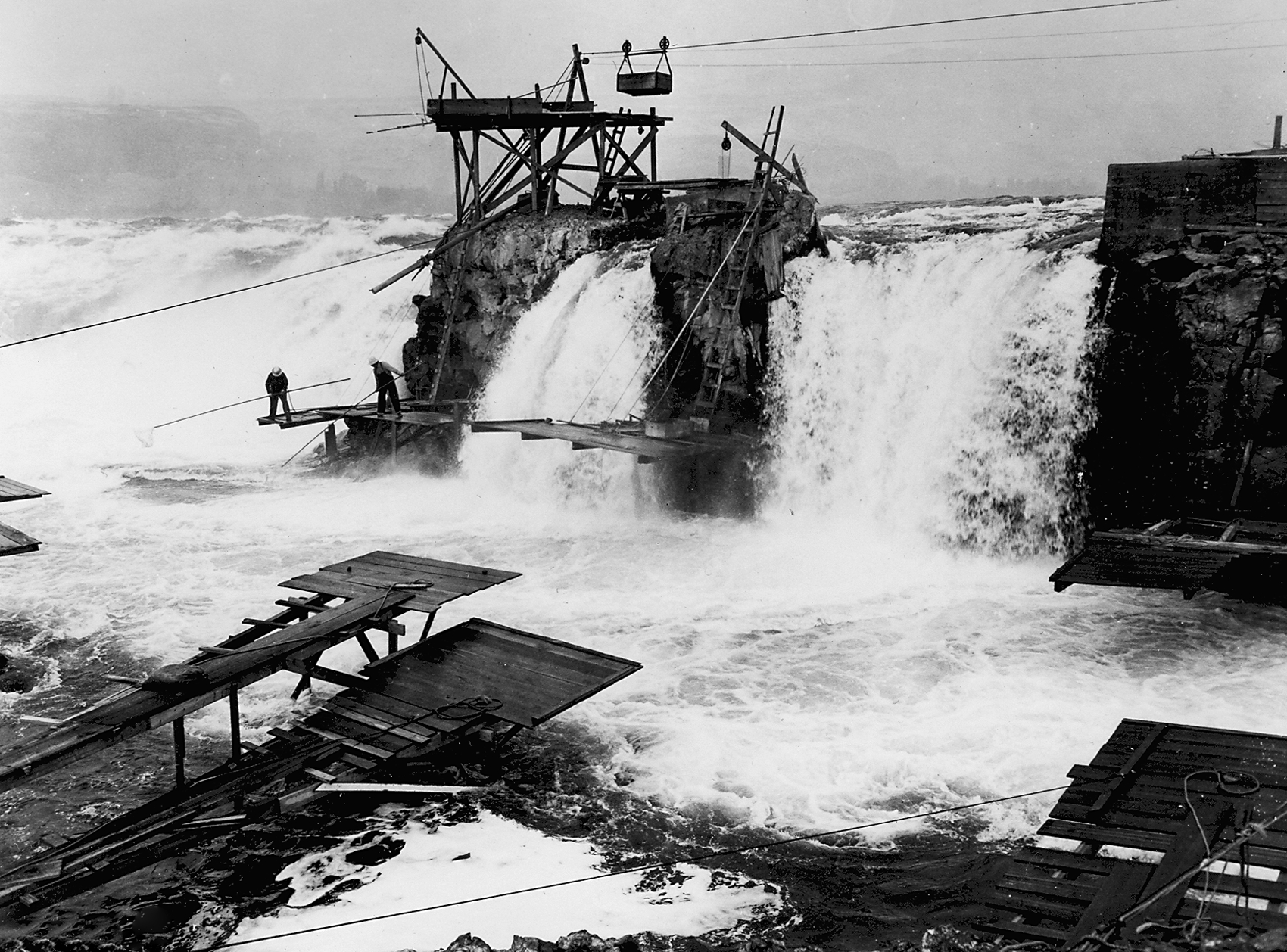Members of Umatilla, Yakama, and Warm Springs tribes joined unenrolled Mid-Columbia Indians to establish the Celilo Fish Committee in 1935. The committee had been proposed the year before to address problems created by declining salmon runs, encroaching state regulation, and rising competition among Native American fishers at Celilo Falls, located upriver from The Dalles on the Columbia River.
Starting in the early 1900s, a growing number of Indians migrated each season to the traditional fisheries along The Dalles-Celilo reach. Most were regional reservation residents who had been driven from their own fishing grounds by dam construction on the Yakima and Umatilla rivers. They asserted tribal rights to fish at Celilo under the Walla Walla and Middle Oregon treaties of 1855, but many lacked hereditary rights to specific sites, which belonged to families and required permission for outsiders to use. Other newcomers, including nontreaty Indians and whites, were drawn to the commercial fishing opportunities offered by the Seufert Brothers cannery.
Although the Celilo area had always hosted large intertribal gatherings, the Wayams and other river residents resented the increasing influx of outsiders and their general refusal to obey the Salmon Chief, who regulated the fishery in accordance with traditional customs. As these "comers," as they were called, crowded in, competing factions began fighting over access to the islands, cableways, and scaffolds that comprised the Celilo fishery.
The Office of Indian Affairs soon grew frustrated with the endless disputes and called for the creation of an intertribal committee to mediate them. Tommy Thompson, the headman and Salmon Chief at Celilo, opposed the idea for fear it would increase the power of the reservation-based tribal councils. He was forced to go along, however, when it became clear that the committee would proceed with or without him.
According to bylaws adopted in 1936, the Celilo Fish Committee had jurisdiction over fishing matters between the John Day River and Cascade Locks. It was composed of nine representatives appointed by each of the Mid-Columbia reservations—Warm Springs, Umatilla, and Yakama—plus two delegates from Celilo Village and one from Rock Creek, a village near Goldendale, Washington. Off-reservation communities below Celilo Falls lacked separate representation, and the Nez Perce Tribe was excluded due to a 1933 court ruling that held its treaty rights did not extend that far downriver.
Collectively, the committee's twelve members shared responsibility for protecting and administering Indian fishing, promoting law and order at the fisheries, and prioritizing subsistence fishing ahead of commercial fishing. Significantly, the bylaws made no mention of traditional law or the Salmon Chief, whose exact duties and relationship to the committee remained ambiguous. Chief Thompson participated actively in committee business for the next twenty years, but he never warmed to an arrangement that seemed to place reservation interests ahead of his people's needs.
Throughout its lifetime, the committee struggled to enforce its resolutions, fend off state interference, and overcome internal tensions. By 1957, when The Dalles Dam flooded Celilo Falls, the committee had effectively disbanded. Still, it had provided an intertribal forum in which Native Americans could develop their own regulations and solutions, an expression of self-determination that would later be revived by the Columbia River Inter-Tribal Fish Commission.
-
![Celilo Falls dipnetters, 1954]()
Celilo Falls dipnetters, 1954.
Celilo Falls dipnetters, 1954 Courtesy Oreg. Hist. Soc. Research Lib., cn007237
-
![Celilo Falls]()
Celilo Falls.
Celilo Falls Courtesy Oreg. Hist. Soc. Research Lib., OrHi 42687
-
![Celilo Falls, c. 1900]()
Celilo Falls, c. 1900.
Celilo Falls, c. 1900 Courtesy Oreg. Hist. Soc. Research Lib., neg. no.013412
-
![Yakima, Umatilla, Wyam Tribe members, farewell ceremony to Celilo Falls, 1956]()
Farewell ceremony to Celilo Falls, 1956.
Yakima, Umatilla, Wyam Tribe members, farewell ceremony to Celilo Falls, 1956 Courtesy Oreg. Hist. Soc. Research Lib., neg. no.001579
Related Entries
-
Celilo Falls
Celilo Falls (also known as Horseshoe Falls) was located on the mid-Col…
-
![Columbia River]()
Columbia River
The River For more than ten millennia, the Columbia River has been the…
-
![Columbia River Inter-Tribal Fish Commission]()
Columbia River Inter-Tribal Fish Commission
The Columbia River Inter-Tribal Fish Commission (CRITFC) is the fishery…
-
![Salmon]()
Salmon
The word “salmon” originally referred to Atlantic salmon (Salmo salar),…
-
![The Dalles Dam]()
The Dalles Dam
The United States Army Corps of Engineers constructed The Dalles Dam be…
Related Historical Records
Map This on the Oregon History WayFinder
The Oregon History Wayfinder is an interactive map that identifies significant places, people, and events in Oregon history.
Further Reading
Barber, Katrine. Death of Celilo. Seattle: University of Washington Press, 2005.
Dupris, Joseph C., Kathleen S. Hill, and William H. Rodgers, Jr. The Si'lailo Way: Indians, Salmon and Law on the Columbia River. Durham, NC: Carolina Academic Press, 2006.
Fisher, Andrew H. Shadow Tribe: The Making of Columbia River Indian Identity. Seattle, Wash.: University of Washington Press, 2010.
Fisher, Andrew H. "Tangled Nets: Treaty Rights and Tribal Identities at Celilo Falls." Oregon Historical Quarterly 105 (Summer 2004): 179-211.









